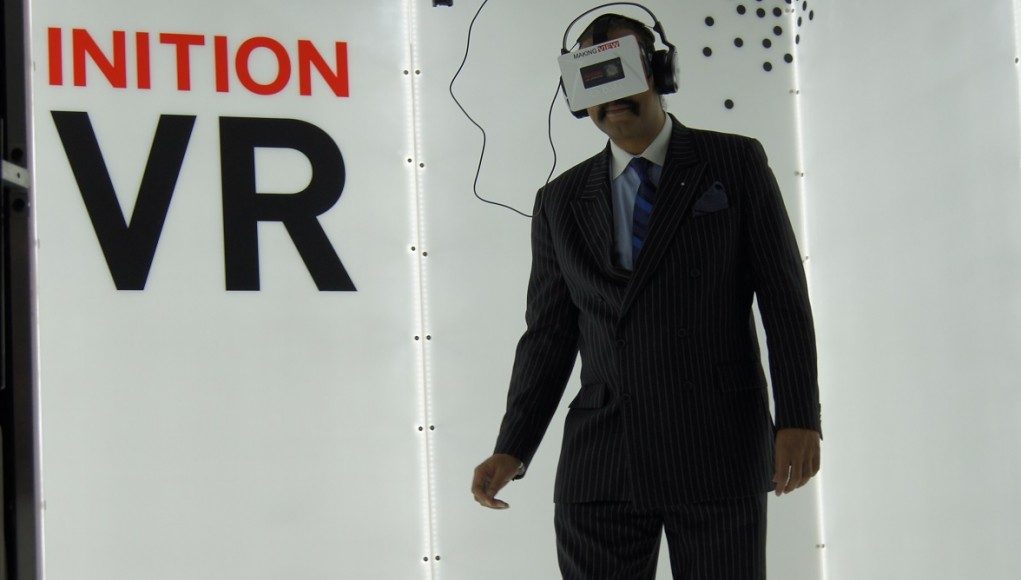Testing the Oculus Rift
 I have personally had the dubious pleasure of using over forty different HMD designs over the last few years — a list of which can be found here.
I have personally had the dubious pleasure of using over forty different HMD designs over the last few years — a list of which can be found here.
I profess a strong skepticism of HMD’s, having seen the best and the worst. I hold the belief that the current projection technology offers a more applicable means to represent a virtual environment (still quoting the tired old joke — “what is the difference between VR and simulation… virtually nothing!”)
It has to be remembered as an Imagineer I was one of a large team that oversaw the creation of two of the most successful and long running VR entertainment attractions (DisneyQuest’s ‘Aladdin’s Magic Carpet Ride’ and ‘Ride The Comix’ — using the DisneyVision HMD); I have been spoiled in the best means to represent a virtual environment — the Disney HMD offered to-this-date the highest quality out-of-home entertainment visuals. Anything that hopes to surmount this quality needs to offer high resolution, high Field-of-View (FOV), light-weight performance and a flexibility to support the demands of the modern market.
At the Inition event the four Oculus Rift systems received serious attention. I was one of those that experienced the presentation of the Rift development kit (all running with A cup lenses), and have jotted down my initial evaluation:
[Editor’s note: keep in mind that Williams has had his head in some multi-thousand dollar head mounted displays]
Pros:
- Incredibly lightweight, the 379g is very noticable in comparison of say the Sony HMZ-T1 (420g)
- The HMD was a comfortable fit without the nose encumbrance felt on systems such as the HMZ-T1
- The tracking is great, working well with the system
- The most impressive aspect of the system is the FOV, highly compelling
Cons:
- Resolution, resolution, resolution (more on that later)
- Lack of audio — meaning the need for additional confusion in wearing headphones adding to weight and cabling
- Robustness, the system seeming to be flimsy and susceptible damage
- Lack of optical adjustment, a lack of focusing and adjustment of the interpupillary distance
- ‘Screen Door’, the most noticeable issue of usage of the system a factor in the screen selected
- ‘Tearing’, the breaking of image with quick head movements (unknown if this was PC or HMD issue)
- Positional tracking, the forward movement and spacial awareness caused by the lack of a this is an issue and caused some disorientation even during short demonstrations
Conclusion
The Oculus Rift Dev Kit showed what the ‘near’ future could represent for VR; I liked to say that the system is “close, but no cigar!” The resolution of 640 x 800 is just too poor, especially sitting next to the Sony HMZ-T1’s 1280 x 720 — but the FOV offers a compelling argument that if the resolution was better, it would be a slam dunk and would validate all the promise that Oculus has engendered with this second bite at the VR pie.
The fact is that this is only a dev kit, and still at perhaps two iterations away from the final system; I did feel heartened that this could work, but was saddened that we are still some way off from the final system.
During one discussion with a developer at the Inition event; we spoke on the situation we find ourselves with the Oculus Rift. With reports now of some 50,000+ dev kits having been ordered we could be in a position where Oculus pauses for a time just fulfilling and supporting these systems.
But in the interim there must be a drive towards a better resolution display — already rumors have been circulated of a number of home-brew mods for the dev kits systems, adding better hi-resolution displays by Chinese modders. With all this in mind we seem to be close to the panacea of true immersion — though mindful that there are still some major hurdles to be surmounted to move beyond this development phase of the Oculus concept.
Finally, regarding sim-sickness, Oculus has been incredibly tight lipped about the issue – while perusing the Oculus development kit supplied to one of the Rift supporter at the event, I read the operation manual and read the section dedicated to ‘Safety Warnings’ – especially that covering Photosensitivity / Motion Sickness / Seizers. Along with the usual comments, the statement, “…avoid using the Headset continuously for more than an hour at a time…” proved very telling on the reality of long term gaming on the system (average console players calculated at between 2-4 hour continuous sessions – with an average of 8-10 hours per week). The warning also specified, “…Children under the age of 10 should not use the headset at any time.” Putting to bed some denials of any issues!
From my perspective I am interested in considering the deployment of VR again in the digital out-of-home entertainment (DOE) sector. I see the Rift as opening the door to this interest once again, and from the feedback at this event, the out-of-home approach seemed to be an initial landmark down the road of re-establishing VR as an entertainment platform. What comes next will be very important in achieving this!
This is a brief overview of the latest exploits in the application of VR – for a more comprehensive overview regarding the current and future application of immersive entertainment technology in the digital out-of-home entertainment sector, a book has been co-authored entitled “The Immersive Frontier” – its publication to be announced soon, supporting the new trade association for this sector (the Digital Out-of-Home Entertainment Network Association (DNA)).







